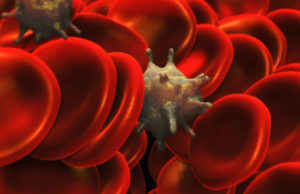Since individuals with type O blood have a lower risk of myocardial infarction, researchers hypothesized that the ABO blood group on platelets may play a role in thrombosis formation. Thrombosis formation in arterial circulation is a multi-step process that is initiated when von Willebrand factor (VWF) binds exposed collagen. Using video microscopy and a dynamic platelet function assay that mimics the arterial shear stress, researchers measured the platelet velocity and translocation characteristics from 33 donors with type O blood compared to 54 non-O donors. Type O platelets traveled significantly faster (4.6+2.1 µm/s) through the VWF-coated flow chambers compared to non-type O platelets (3.4+1.7 µm/s; p=0.002), and significantly fewer type O platelets adhered to the VWF-coated chambers (p=0.009). Furthermore, modeling revealed that the binding kinetics are more than 40% weaker for O platelets compared to non-O type platelets. The physiological and clinical relevance of the ABO blood group on platelets, therefore, extends beyond transfusion matching and warrants additional study. Further research is also needed to better understand the mechanism of how the ABO blood group on platelets alters binding to VWF.
References:

